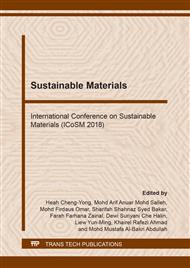p.410
p.415
p.422
p.433
p.440
p.451
p.462
p.469
p.476
Minerals Characterization of Magnetic and Non-Magnetic Element from Black Sand Langkawi
Abstract:
Valuable minerals are defined as mineral which having good opportunities to economic and consireable important. The most commonly occurring sand mineral deposits are ilmenite, rutile, magnetite, cassiterite, monazite, tourmaline, zircon, kyanite, silimanite, and garnet. In Malaysia, mineral sand deposits is found in Langkawi which known as black sand Langkawi. Langkawi black sand having high amount of valuable minerals that is very crucial in the industrial and construction products. Characterizations of black sand acquire different techniques to concentrate and separate valuable minerals. These techniques utilize different in physical or chemical properties of the valuable and gangue (wastes) minerals. For magnetic is based on natural or induced differences in magnetic susceptibility or conductivity of the minerals.. They are used to distinguish and extract magnetic, slightly magnetic and non-magnetic components present in the heavy fraction (Rutile, Ilmenite, Magnetite, Garnets, Zircon and Monazite). All minerals will have one of three magnetic properties: ferromagnetic, paramagnetic and diamagnetic. Ferromagnetic minerals (i.e. Magnetite and Ilmenite) are magnetic and easily attracted to the poles of magnet. Paramagnetic and diamagnetic minerals in the group magnetic, but if the mixture of paramagnetic and diamagnetic minerals are passed through a magnetic field, the paramagnetic minerals will be pulled into the field and diamagnetic minerals separated from the field. By varying the intensity of the magnetic field, it is also possible to separate different paramagnetic minerals from each other. In this study, techniques used to separate valuable minerals from black sand are magnetic separator.
Info:
Periodical:
Pages:
440-447
Citation:
Online since:
August 2018
Keywords:
Price:
Сopyright:
© 2018 Trans Tech Publications Ltd. All Rights Reserved
Share:
Citation:


